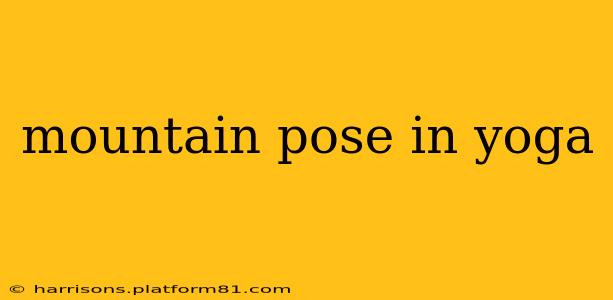Mountain Pose, or Tadasana in Sanskrit, might seem deceptively simple. It's often the first pose learned in a yoga class, a seemingly effortless standing position. However, this deceptively simple asana is a cornerstone of yoga practice, laying the foundation for balance, strength, and mindful body awareness. Mastering Tadasana allows you to cultivate a grounded presence, both physically and mentally, which ripples through all other standing poses and even seated asanas. This comprehensive guide will delve into the intricacies of Mountain Pose, exploring its benefits, variations, common mistakes, and how to deepen your practice.
What are the benefits of Mountain Pose?
Mountain Pose offers a surprisingly wide array of benefits, extending beyond mere physical posture. Its advantages encompass:
- Improved Posture: Tadasana cultivates proper alignment, strengthening core muscles and promoting good posture, reducing back pain and improving overall body mechanics.
- Enhanced Body Awareness: By paying close attention to the subtle sensations in your body while in the pose, you cultivate a heightened sense of body awareness, a crucial aspect of mindful yoga practice.
- Grounding and Stability: The pose encourages a sense of stability and grounding, helping to calm the nervous system and reduce stress.
- Strengthened Core: Engaging the core muscles is essential for maintaining balance and proper alignment in Tadasana, leading to a stronger core overall.
- Improved Balance: As you refine your alignment and strengthen your core, you’ll find your balance improves significantly, making other standing poses easier.
How to do Mountain Pose correctly?
While seemingly straightforward, performing Mountain Pose correctly requires attention to detail. Here's a step-by-step guide:
- Stand with your feet together: Begin by standing with your feet together, heels touching, and big toes touching.
- Distribute your weight evenly: Ensure your weight is evenly distributed across both feet, feeling a connection to the earth beneath you.
- Engage your legs: Slightly engage your thigh muscles, drawing them slightly inward, lifting your kneecaps, and lengthening your tailbone towards the floor.
- Lengthen your spine: Lengthen your spine from the base of your pelvis to the crown of your head. Imagine a string pulling you upwards from the crown.
- Relax your shoulders: Drop your shoulders down away from your ears, gently lengthening your neck.
- Soften your gaze: Soften your gaze, focusing on a point straight ahead at eye level.
- Engage your core: Engage your abdominal muscles, drawing your navel slightly towards your spine.
- Breathe deeply: Breathe deeply and evenly, noticing the sensations in your body.
What are some common mistakes to avoid in Mountain Pose?
Even a seemingly simple pose like Tadasana can be performed incorrectly, hindering its benefits. Common mistakes include:
- Uneven weight distribution: Ensure weight is evenly distributed across both feet. Notice if you tend to lean more on one leg than the other.
- Locked knees: Avoid locking your knees; keep a slight bend in them to protect your joints.
- Rounded shoulders: Keep your shoulders relaxed and away from your ears.
- Slouched posture: Maintain a lengthened spine, avoiding slouching or hunching.
- Gripped muscles: Avoid excessive tension. Engage your muscles gently; don't grip them tightly.
What are some variations of Mountain Pose?
Once you feel comfortable with the basic Mountain Pose, you can explore variations to challenge yourself and deepen your practice:
- Mountain Pose with arms overhead: Raise your arms overhead, palms facing each other, lengthening your spine further.
- Mountain Pose with hand gestures: Incorporate different hand gestures (mudras) to enhance the energetic aspect of the pose.
- Mountain Pose with eyes closed: Closing your eyes deepens the introspection and self-awareness aspect of the pose. (Be cautious and ensure a safe environment.)
How long should I hold Mountain Pose?
You can hold Mountain Pose for anywhere from 30 seconds to several minutes. Listen to your body and hold the pose for as long as it feels comfortable and beneficial without straining yourself.
Is Mountain Pose safe for everyone?
Mountain Pose is generally considered safe for most people. However, individuals with certain conditions, such as severe back pain, knee problems, or balance issues, should consult with a healthcare professional or experienced yoga instructor before practicing this or any other yoga pose.
This detailed exploration of Mountain Pose should provide a solid understanding of this fundamental yoga asana, empowering you to cultivate a deeper practice and reap its numerous benefits. Remember, consistency and mindful attention to detail are key to unlocking the full potential of even the simplest yoga poses.
